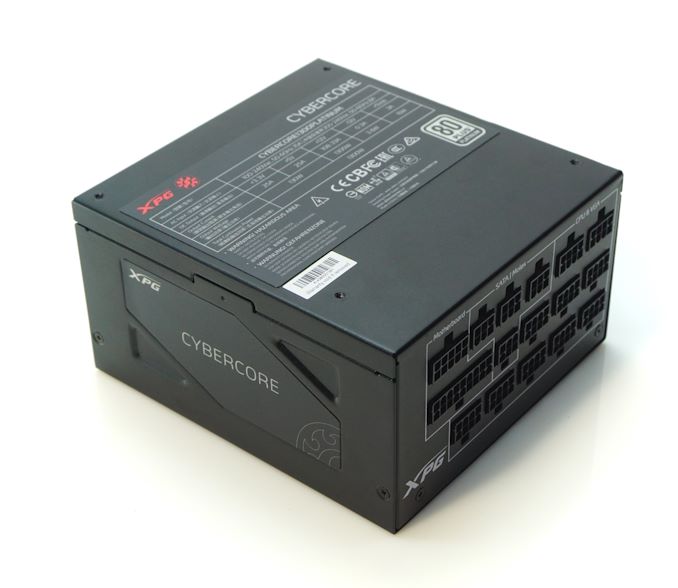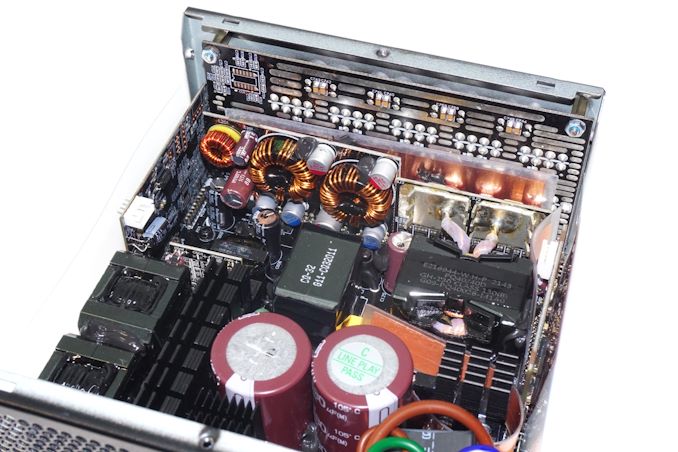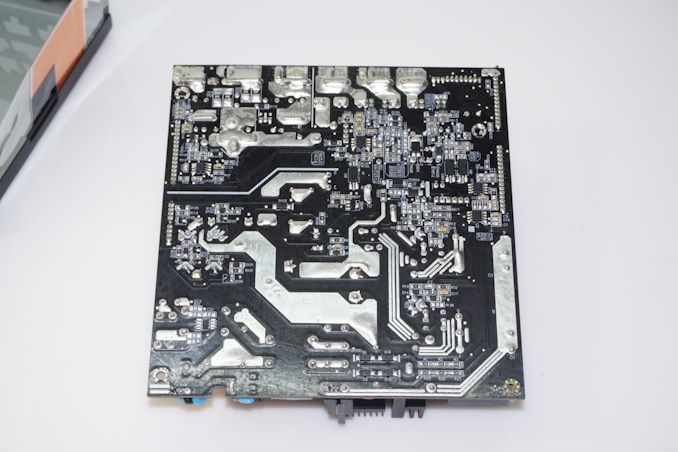The ADATA XPG Cybercore 1300W PSU Review: Advanced From the Start
by E. Fylladitakis on March 10, 2022 8:00 AM EST- Posted in
- Cases/Cooling/PSUs
- PSUs
- ADATA
- 80Plus Platinum
- XPG
- CWT
Power Supply Quality
As part of our testing, we also check output parameters are within specifications, as well as voltage ripple and line noise.
| Main Output | ||||||||
| Load (Watts) | 261.98 W | 653.57 W | 976.2 W | 1297.41 W | ||||
| Load (Percent) | 20.15% | 50.27% | 75.09% | 99.8% | ||||
| Amperes | Volts | Amperes | Volts | Amperes | Volts | Amperes | Volts | |
| 3.3 V | 2.32 | 3.35 | 5.79 | 3.35 | 8.68 | 3.33 | 11.58 | 3.32 |
| 5 V | 2.32 | 5.07 | 5.79 | 5.05 | 8.68 | 5.03 | 11.58 | 5.01 |
| 12 V | 20.07 | 12.08 | 50.16 | 12.06 | 75.24 | 12.01 | 100.33 | 11.97 |
| Line | Regulation (20% to 100% load) |
Voltage Ripple (mV) | |||||
| 20% Load | 50% Load | 75% Load | 100% Load | CL1 12V |
CL2 3.3V + 5V |
||
| 3.3V | 1.1% | 12 | 14 | 14 | 14 | 14 | 14 |
| 5V | 1% | 16 | 16 | 20 | 24 | 14 | 16 |
| 12V | 0.9% | 24 | 32 | 38 | 38 | 36 | 24 |
The electrical performance of the XPG Cybercore 1300W PSU is good, though not particularly impressive for a top-tier power supply. Voltage regulation is exceptional on all lines, holding at 0.9-1.0% across the entire nominal load range. The XPG Cybercore also displayed a maximum ripple of 38 mV on the 12V line, a lot lower than the 120 mV recommended design limit. This is a good figure for a unit that outputs 1300 Watts, but as we've seen in other PSU designs, it could have been better. The filtering on the 3.3V and 5V lines is very good, with a maximum of 14 mV and 24 mV on the 3.3V and 5V lines respectively.
Conclusion
ADATA’s massive growth was not by chance, as the company has been making precise, calculated market moves amidst their attempts at diversification. The latest release of the XPG Cybercore PSUs is another one of those great moves, as the company has brought something that truly stands out in a very competitive and saturated market.
XPG heavily advertises their collaboration with Nidec, turning it into one of the core features of the Cybercore PSU. Deservedly, having a very good cooling fan is important, especially for a PSU where it will have to contend with some very warm temperatures. Nidec’s dual ball bearing cooling fan may be a little on the loud side but it undeniably is one of the most reliable DC fans ever made. Regardless, this is not what is truly unique about the Cybercore series PSUs – not by a long shot.
The truly unique part of the Cybercore series is the new CWT platform that they are based on. The new platform is practically a game changer, as it significantly reduced the space requirements for >1 kW designs while also adding digital control. The new platform is also able to meet the Intel ATX version 2.52 requirements. Although CWT's older platform probably could meet many of the same metrics – sans the new requirement for >60% efficiency at 2% load – a better low load efficiency is a significant advantage with modern systems, as their power requirements drop vastly while they are idling. The new platform, in conjunction with XPG’s choice of parts, makes the 1300W version of the Cybercore series exceptionally efficient, easily meeting the 80Plus Platinum certification requirements.
Overall, the performance of the XPG Cybercore 1300W PSU is very good. It does not break any records, but it does not disappoint either. The XPG Cybercore delivers good power quality regardless of its load, ensuring the stability and longevity of the components it is powering. It also stays quiet while it is lightly loaded, allowing gaming systems to be built will only be meaningfully audible while gaming. The very high efficiency allows the PSU to maintain reasonable temperatures, even while its fan is turned off and it has to operate inside very warm environments.
Although it's not so much a unique trait nowadays, another very important characteristic of the XPG Cybercore is its exceptional quality. From its Nidec fan and down to the least important passive components, the XPG Cybercore is made using top quality parts. We could not spot a single component whose supplier we would classify as mediocre. Similarly, we could not find any significant design or assembly imperfections to speak of. The XPG Cybercore is built to last and that is why the company casually backs it up with a ten-year warranty.
The XPG Cybercore 1300W PSU is not without competition in its price range, but its true rival is today’s PC market. With graphics cards scarce and very expensive, few are currently building high performance gaming PCs, greatly reducing the pool of potential buyers that XPG can draw from. Consequently, the $299 MSRP is not unreasonably high for the power output and features of the PSU, although we expect that once retail availability improves, street prices will come down significantly due to the very stiff competition at this price range.













35 Comments
View All Comments
Threska - Thursday, March 10, 2022 - link
That fan location is good for those cases that have the cutout in the case. Mine currently has the fan on the switch side.back2future - Friday, March 11, 2022 - link
"This particular model has a maximum speed of 2150 RPM, which is a high rotational speed for a 120 mm fan, but it should not be reaching that speed under normal operating conditions."Astonishingly (relative) small heat sinks.
CajunArson - Friday, March 11, 2022 - link
Finally a PSU worthy of a 2023 notebook.saratoga4 - Saturday, March 12, 2022 - link
With over 100 amps on the 12v rail, I'm curious what happens if a sata connector comes uncrimped and shorts or a cap goes short circuit. Can the supply even detect shorts (which are probably well under 100a) or will it pump in current until the wiring is on fire ?Oxford Guy - Sunday, March 13, 2022 - link
Very loud. Not a good design.Calin - Monday, March 14, 2022 - link
Well, it's made for a "under the desk" tower case. Such is both far from the user, and there's no "direct" sound path (only reflected).So the perceived sound level is far from what - let's say - a gaming laptop would feel like (Asus Rog Zephyrus 14 will go 46 dB within your arms reach, and the highest noise from the PSU was some 52 dB under a desk somewhere. That's four times the perceived noise level in the same conditions - which, in this case, are not.
Oxford Guy - Wednesday, March 16, 2022 - link
It’s too loud.I have put PCs into closets and in adjacent rooms. I am very familiar with desks, baffles, and other obstructions.
mumbai4beautie - Wednesday, March 16, 2022 - link
https://mumbaibeautie.com/mumbai4beautie - Wednesday, March 16, 2022 - link
https://mumbaibeautie.com/andheri.htmlhttps://mumbaibeautie.com/visakhapatnam.html
https://mumbaibeautie.com/kochi.html
https://mumbaibeautie.com/surat.html
mumbai4beautie - Wednesday, March 16, 2022 - link
https://mumbaibeautie.com/mira-road.htmlhttps://mumbaibeautie.com/mira-bhayandar.html
https://mumbaibeautie.com/panvel.html
https://mumbaibeautie.com/mulund.html
https://mumbaibeautie.com/visakhapatnam.html
https://mumbaibeautie.com/kochi.html
https://mumbaibeautie.com/vapi.html
https://mumbaibeautie.com/daman.html
https://mumbaibeautie.com/vijayawa.html
https://mumbaibeautie.com/surat.html
https://mumbaibeautie.com/mysore.html